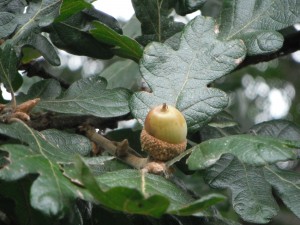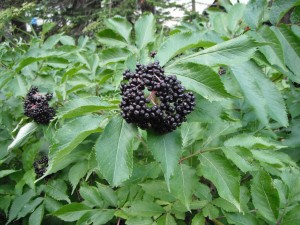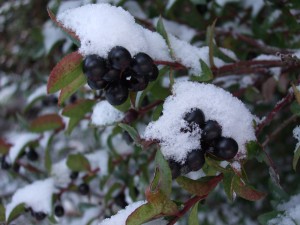Fruits are made to be eaten!
Fruits evolved to offer animals a nutritious food, encouraging them to disperse the seeds of the plant. Frugivores can be free of guilt—fruit is produced to be eaten! You can be sure that a fruit will attract some kind of hungry animal just as a showy flower will attract a pollinator. In fact many seeds must pass through the gut of an animal before they will germinate.
Two of the top wildlife plants are oaks and pines. Instead of fruit, these trees produce large, nutritious seeds. It may seem strange that a tree could sacrifice so many of its seeds and still reproduce. But by strategically producing bumper crops in some years and very little in others, the trees provide an erratic food supply to limit the population growth of the seedeaters. Birds, squirrels and other small rodents disperse the seeds by caching them for later use. Forgotten seeds may sprout and grow into new trees.
Elderberries are next in importance. Red Elderberry, Sambucus racemosa, is the most common in our area. Blue Elderberry, S. caerulea, can also be found in more open sites. Pileated Woodpeckers, Flickers, Steller’s Jays and many other birds eat these berries. People eat them too, usually cooked or made into jelly or wine. Raw Red Elderberries may cause nausea in people.
Surprisingly, Poison Oak, Toxicodendron diversilobum, is listed as the next important species. Wren Tits, Thrushes, Flickers, Sapsuckers and other Woodpeckers eat its white berries. The only places I have seen Poison Oak is on Cutt’s Island and Maury Island. There is a saying: “Leaves of three, let it be; berries white, poisonous sight.” Most people would not want this in their yard even with its high wildlife value!
The most important native Brambles, for people and wildlife are Salmonberry, Rubus spectabilis, Blackcap Raspberry, R. leucodermis, and Thimbleberry, R. parviflorus. Many birds eat these berries, including Robins, Thrushes, Towhees, Tanagers, Grosbeaks, Waxwings and Grouse. Trailing Blackberry (Dewberry), R. ursinus is our only native blackberry; it often appears as a weed, but you may want to allow some of it to grow in a wild garden. Himalayan and Evergreen Blackberries, although good for wildlife, are invasive non-natives and should be controlled.
Many of our important berries are in the Heath family, Ericaceae. The most common are Salal, Gaultheria shallon and Evergreen Huckleberry, Vaccinium ovatum. People and wildlife enjoy these and other huckleberries, including Red Huckleberry, V. parvifolium. Manzanitas, Arctostaphylos sp., are more important in California, but we have two native species: Kinnikinnick or Bearberry, A. uva-ursi, a popular groundcover, and Hairy Manzanita, A. columbiana. Our only broad-leaved evergreen tree, the Pacific Madrone, Arbutus menziesii has red berries.
We have 3 species of Dogwood: a tree; Pacific Dogwood, Cornus nuttallii, a shrub; Redtwig Dogwood, C. sericea, and a groundcover; Bunchberry C. canadensis. Grosbeaks, Waxwings and Woodpeckers eat dogwood fruits.
Other fruiting natives include: Cascara, Rhamnus purshiana, Serviceberry, Amelanchier alnifolia, Gooseberries and Currants, Ribes sp., Oregon Grapes, Mahonia sp., Pacific Crabapple, Malus fusca, Black Hawthorn. Crataegus douglasii, Highbush Cranberries, Viburnum sp., Roses, Rosa sp., Honeysuckles, Lonicera sp. Mountain Ashes, Sorbus sp., Indian Plum, Oemleria cerasiformis, and Snowberry, Symphoricarpos albus. Of these, Serviceberries, Gooseberries and Oregon Grapes are frequently eaten by people; often prepared into jellies.
In addition to providing food for wildlife and people, berries are often an attractive feature in the landscape during fall and winter, especially the ones with bright red berries. Treat yourself and the local wildlife to a smorgasbord by planting some of these juicy selections.





